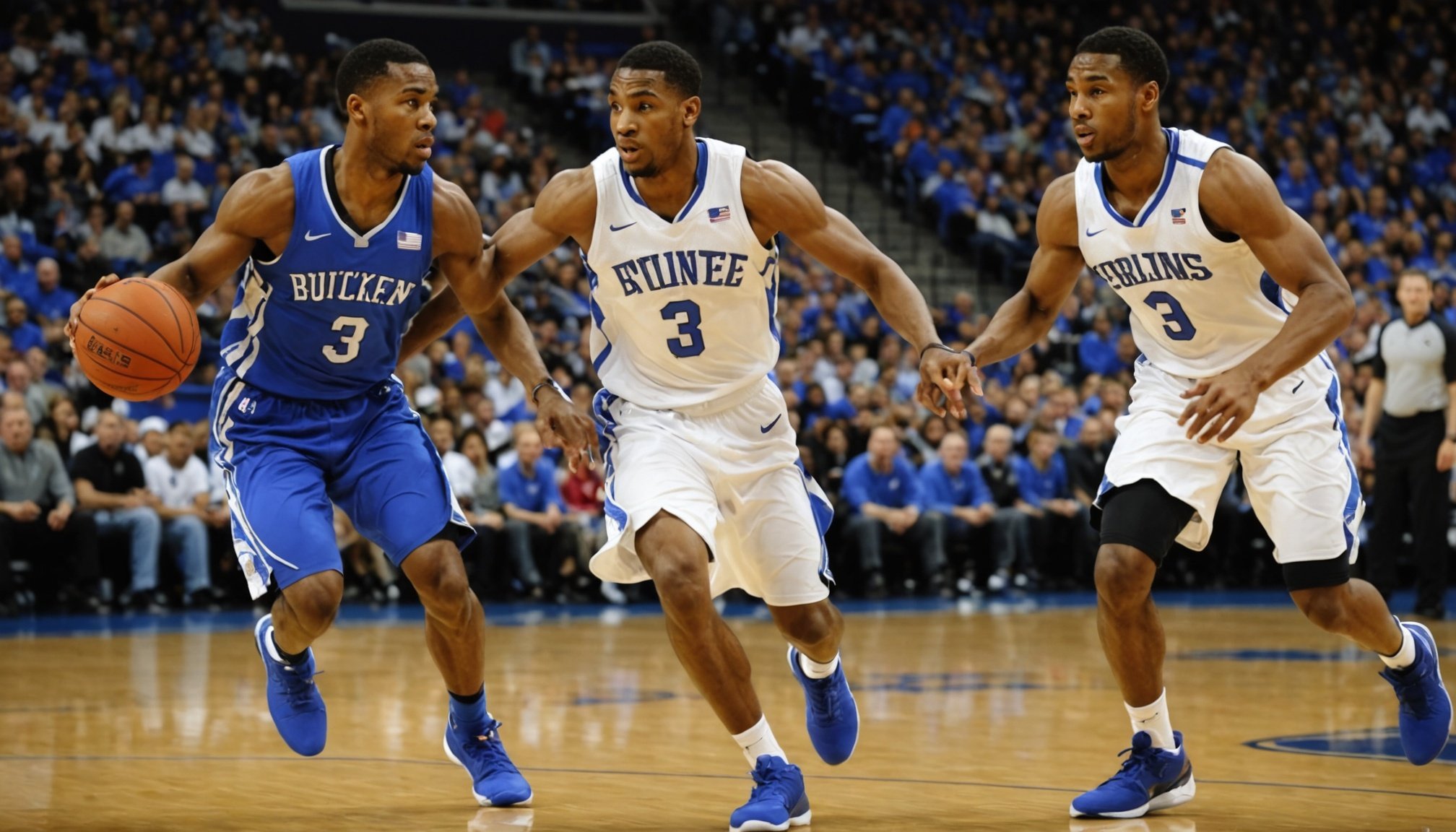Unlocking Speed: Strategies for UK Basketball Players to Enhance Quickness and Reaction Times in Defensive Plays
Understanding the Importance of Speed and Reaction Time in Basketball
In the fast-paced world of basketball, speed and reaction time are crucial elements that can make or break a team’s defensive performance. For UK basketball players, enhancing these skills can be the difference between a successful season and a disappointing one. Let’s delve into why speed and reaction time are so vital and how players can improve these aspects of their game.
Speed in basketball is not just about raw athleticism; it’s also about technique, agility, and the ability to change direction quickly. Reaction time, on the other hand, involves the cognitive ability to process information and respond swiftly to the opponent’s actions. Here’s what coaches and players need to know:
Also read : Essential Muscle Groups for UK Basketball Players to Enhance Their Jump Shot Performance
-
Speed Training: This involves specific drills and exercises designed to improve a player’s acceleration, deceleration, and lateral movement. For example, shuttle runs, cone drills, and resisted band training can help players build the explosive speed needed to keep up with opponents[4].
-
Reaction Time: Enhancing reaction time requires a combination of physical and cognitive training. Players can engage in reaction drills where they respond to visual or auditory cues, such as reacting to a coach’s whistle or a teammate’s pass. This helps in developing the quick decision-making skills necessary in real-time game situations.
This might interest you : Essential Components of an Effective Post-Game Recovery Strategy for UK Basketball Athletes
Building a Comprehensive Training Program
To enhance speed and reaction time, a well-structured training program is essential. Here are some key components to include:
Strength Training
Strength is the foundation of speed and agility. A robust strength training program can significantly improve a player’s athletic performance.
- Lower Body Strength: Exercises like squats, deadlifts, and lunges are crucial for building the power needed for explosive movements on the court.
- Core Strength: A strong core enhances stability and balance, allowing players to change direction more effectively.
- Upper Body Strength: While less critical for speed, upper body strength is important for overall athletic performance and can aid in rebounding and defensive positioning.
Agility Training
Agility training focuses on improving a player’s ability to change direction quickly and efficiently.
- Cone Drills: Setting up cones in various patterns and having players weave through them can improve lateral movement and agility.
- Shuttle Runs: These involve rapid changes of direction over short distances, mimicking the movements seen in a basketball game.
- Ladder Drills: Using a ladder to perform footwork drills can enhance quickness and agility.
Speed Training
Speed training is about maximizing a player’s acceleration and deceleration capabilities.
- Sprint Drills: Short sprints (10-20 meters) with full recovery can help build explosive speed.
- Resisted Band Training: Using resistance bands to perform sprints or lateral movements can increase strength and speed.
- Hill Sprints: Sprinting uphill can be an effective way to build explosive power.
Enhancing Reaction Time
Reaction time is a critical component of defensive play, allowing players to anticipate and respond to opponents’ actions quickly.
Perceptual-Cognitive Training
This type of training focuses on improving the cognitive aspects of reaction time.
- Visual Training: Players can engage in visual training exercises where they have to react to visual cues, such as a light or a color change. This enhances their ability to process visual information quickly[3].
- Auditory Training: Similar to visual training, auditory cues like whistles or bells can be used to improve reaction times.
- Decision Making Drills: Drills that require players to make quick decisions based on game-like scenarios can improve their real-time decision-making skills.
Integrating Technology into Training
Modern technology, including artificial intelligence and virtual training tools, can significantly enhance the training environment.
Virtual Training
- Virtual Reality (VR) Training: VR can simulate game scenarios, allowing players to practice their defensive skills in a highly realistic and immersive environment.
- Artificial Intelligence (AI) Feedback: AI can provide immediate feedback on a player’s performance, highlighting areas for improvement and offering personalized training recommendations.
Practical Insights and Actionable Advice
Here are some practical tips and insights that coaches and players can use to enhance their speed and reaction time:
Drills to Enhance Speed and Agility
-
Lateral Shuffle Drill:
-
Set up two cones 10 meters apart.
-
Start in a defensive stance at one cone.
-
Shuffle laterally to the other cone and back.
-
Repeat for 3 sets of 10 reps.
-
Cone Weave Drill:
-
Set up cones in a zigzag pattern.
-
Weave through the cones using different footwork patterns (e.g., inside-outside, crossover).
-
Repeat for 3 sets of 10 reps.
Drills to Enhance Reaction Time
-
Coach’s Cue Drill:
-
Have a coach stand 5 meters away with a ball.
-
The coach calls out a color or number, and the player must react by moving to a designated spot.
-
Repeat for 3 sets of 10 reps.
-
Pass and React Drill:
-
Set up a passing scenario where a teammate passes the ball to a player.
-
The player must react quickly to pass the ball back or move to a new position.
-
Repeat for 3 sets of 10 reps.
Real-World Examples and Success Stories
Let’s look at some real-world examples of how these strategies have been successfully implemented:
Victor Wembanyama’s Training Regimen
Victor Wembanyama, the French basketball sensation, is known for his impressive speed and agility. His training regimen includes a mix of strength training, agility drills, and perceptual-cognitive exercises. For instance, Wembanyama engages in shuttle runs and cone drills to improve his lateral movement and reaction time. This comprehensive approach has helped him become one of the most dominant players in the NBA[1].
Tre Mann’s Breakout Season
Tre Mann, a player for the Charlotte Hornets, has seen a significant improvement in his performance this season, partly due to his enhanced speed and reaction time. Mann’s training includes a focus on strength training, particularly in his lower body, and agility drills that mimic game scenarios. His ability to create space and make quick decisions on the court has been instrumental in his breakout season[5].
Table: Comparing Different Training Methods
Here is a comparative table highlighting different training methods and their benefits:
| Training Method | Benefits | Examples |
|---|---|---|
| Strength Training | Builds power and stability | Squats, deadlifts, lunges |
| Agility Training | Improves lateral movement and change of direction | Cone drills, shuttle runs, ladder drills |
| Speed Training | Enhances acceleration and deceleration | Sprint drills, resisted band training, hill sprints |
| Perceptual-Cognitive Training | Improves reaction time and decision making | Visual and auditory training, decision-making drills |
| Virtual Training | Provides realistic and immersive training environments | VR simulations, AI feedback |
Quotes from Coaches and Players
Here are some insightful quotes from coaches and players that highlight the importance of these training strategies:
-
“Having a player who can react quickly and make swift decisions is a game-changer. It allows us to anticipate and respond to opponents’ actions more effectively.” – Charles Lee, Coach
-
“The key to my improvement has been the combination of strength training and agility drills. It’s allowed me to be more explosive on the court and make quicker decisions.” – Tre Mann, Charlotte Hornets
Enhancing speed and reaction time is a multifaceted process that requires a comprehensive training program. By incorporating strength training, agility drills, speed training, and perceptual-cognitive exercises, UK basketball players can significantly improve their defensive performance. Leveraging technology such as virtual training and AI feedback can further enhance the training environment. With the right strategies and dedication, players can unlock their full potential and become more effective defenders on the court.
Additional Tips for Coaches and Players
Here are some additional tips to keep in mind:
- Consistency is Key: Regular training is essential to see improvements in speed and reaction time.
- Personalized Training: Tailor training programs to individual players’ needs and strengths.
- Game-Like Scenarios: Incorporate drills that mimic real-game scenarios to improve decision-making skills.
- Feedback and Analysis: Use performance metrics and feedback from coaches and AI tools to adjust training programs.
By following these strategies and tips, UK basketball players can enhance their speed and reaction time, ultimately leading to better defensive performances and a more successful season.






